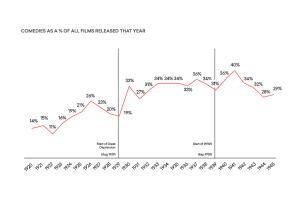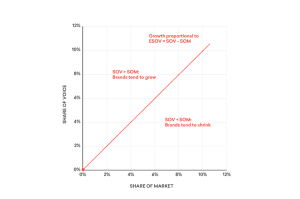The world is facing uncertain times and the COVID-19 lockdown seemed like a too realistic episode of Black Mirror in which we all got stuck. However, every TV show has its finale, and it looks like this one is coming to an end, so I wanted to reflect on what comes after in the post-corona marketing world. How should brands act when all this is over and we come to the inevitable economic downturn?
In order to find the answer, I looked at empirical evidence from more than 20 studies that showed how brands not only survived critical situations, but also managed to come out of it stronger than before. The data shows generally consistent results and clear implications for most brands across different categories. Since the way brands are built and perceived by the consumers doesn’t magically change just because the BDP and general income start falling, the data actually supports some general marketing truths that are always good to have in mind, whether it be during a period of economic downturn or upturn:
1. On average, brands that increased or kept the same level of advertising did better during and after the economic downturn.
2. Companies should invest in brand building activities with a mix of emotional and rational appeals.
3. Brands should rethink their customer journey (on both offline and online channels).
Before I present the case for each of these three ideas, I should say that this blog is by no means a comprehensive guide on how brands should act in times of crisis, since it focuses mostly on advertising, brand building and strategic thinking in fighting the economic downturn. There are other important factors to consider — promotion is only one of the 4 P’s of marketing, the other three being place (distribution), price and the product.
That being said, let’s go through all of the above-mentioned general truths and try to explain the data behind it.
1. On average, brands that increased or kept the same level of advertising did better during and after the economic downturn.
Most of the reports that I examined focused on the effectiveness of advertising during crises and the effect on the brand’s/company’s sales, market share and profitability.
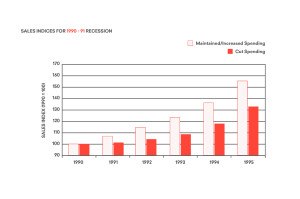
Figure 1: Sales indices for the 1990-91 recession
Source: Journal of Brand management, Thomas Kamber, 2020
A study from 2002 looked at sales of 822 companies in the US in the period from 1990 to 1996. The data was divided into two groups — companies that cut advertising spending and the ones that maintained or increased spending in the analysed period. There were evident long term effects of the cut in spending, as the gap in sales between the two groups rose to 25% in 1995.
One separate study examined 749 US businesses from 1981 to 1982. The conclusion of the study was that the companies that increased their spending during the recession by 20 to 100%, increased their market share by 0.9 market share point, compared to the 0.2 point increase of companies that decreased their market share spending.

Figure 2: Point change in SOM
Source: WPP Group’s Center for Research and Development, A. Biel and S. King, 1990
The data is pretty consistent, with other studies showing similar results to these two: brands that decreased advertising got were in a more difficult position on the market compared to brands that kept or increased their advertising budget.
Why does this happen?
During an economic downturn, companies/brands usually react by cutting costs and lowering prices (and inertia in their business/marketing activity usually comes right after these two steps).
When cuts are made, the first things that get hit are marketing and HR, since companies start looking at the short-term picture, and not the possible long-term gain of these segments.
The advertising budget makes up a big part of the marketing budget, meaning that when marketing gets cut in a lot of companies during a recession, the ad market becomes less crowded. The prices of ad spaces also start falling, which means an excellent opportunity to increase SOV (share of voice — a brand’s share of total communications expenditure by the category).
One general rule of thumb is that brands that have a greater SOV than SOM (brand’s share of market) tend to grow, but brands that have a SOM bigger than their SOV tend to shrink, as shown in the figure below. What brands do and how they act is really even more important when times are a bit rough, as there are more opportunities for growth — and long-term one at that, growth that will persist in years after the crisis.
Figure 3: The role of SOM and SOV in brand growth
Source: The long and short of it, Les Binet and Peter Field
How does advertising work?
Before getting deeper into the topic, it is important to remind ourselves how advertising works. One of the basic principles of advertising is the mere-exposure effect. Here is an experiment you can do for yourself, right now. Your task is to look at the picture below and pick three stocks you want to invest in just by looking at their names. Pick three of them and just keep of mind that these fictive companies all have an equal chance to succeed.

Which three did you choose?
On average, people are more likely to choose FAM, ODEO and BELL, but without any good reason. They can only explain their choice post hoc (e.g. ODEO sounds like it could be a good company). The actual reason why these three stocks get chosen more is the first principle of advertising — the mere-exposure effect, also known as the familiarity principle.
We intuitively tend to like things that we are familiar with, as it just feels more “right” even if we don’t exactly know why. That is why the stocks that sound familiar and like something that actually exists become the more frequent choice in the experiment!
Robert Zaojnc was the social psychologist who is best known for developing this principle and proving that simply exposing people to a certain stimulus makes them more likely to rate it more positively. This holds true for random things such as Japanese pictograms, geometric shapes, faces of people, etc.
So, the conclusion is this: familiarity breeds liking! And if you do not advertise, people won’t remember your brand in the long term. The first goal of advertising is to reinforce those preexisting memory structures in the brain and, sometimes, creating some new ones.
However, it is not just important how much your brand “talks”, it is also important how and what it “talks” about.
2. Companies should invest in brand building activities with a mix of emotional and rational appeals
Brands should keep investing in brand building activities during the economic downturn, but a good long-term marketing strategy would be one based on a mix of emotional and rational communication. Brand building activities create mental brand equity (mental associations people have about a brand). In general, those achieve better business results in the long term than sales activation activities that exploit mental brand equity and only generate better business results in the short term. Brand building aims to create or support the overall brand story and is more emotional, while sales activation aims to persuade consumers to buy the brand using emotional and rational messages in equal measure.
Let’s try to explain this difference using an example. One good case study of brand building is the McDonald’s strategy, which was focused mostly on brand-building pillars such as trust and generating a strong customer preference (people having a favourite product such as a Big Mac, etc). These campaigns were focused more on emotional appeal, while their activation campaigns are more focused on rational appeal. The majority of the growth in sales was generated by the brand-building campaign.
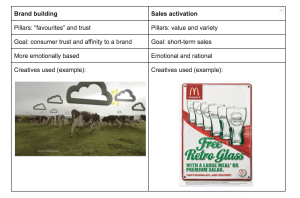 When the company started shifting the budget from brand to activation in 2007 (figure 4), it had a direct impact on sales. Econometric studies showed that the brand building had a bigger impact on sales, even though the budget was smaller. In 2011, the budget on brand building campaigns was around 28%.
When the company started shifting the budget from brand to activation in 2007 (figure 4), it had a direct impact on sales. Econometric studies showed that the brand building had a bigger impact on sales, even though the budget was smaller. In 2011, the budget on brand building campaigns was around 28%.
Figure 4: Brand building vs. sales activation budget split by McDonald’s
Source: The long and short of it, Les Binet and Peter Field
This is why building a brand is one of the best tactics a company can have in the post-coronavirus marketing era. Research on the BrandZ database also proved how much of a powerful asset a strong brand can be for a company, with data showing that strong brands perform even better on the stock market than brands that are in the S&P 500 portfolio and MSCI World Index. Lastly, it’s only natural that having a strong brand in “normal times” means that if a crisis occurs, it will hurt your company less and have a softer impact.
Why does this happen?
Traditional economics assumes that people are rational optimization machines in every decision they make. In these theoretical models, making choices about brands is a calculated and thoughtful decision. However, this is proven to be wrong and now we know that Homo Economicus (e.g. the one who will maximise his/her utility) simply doesn’t exist in the real world. What does exist are people influenced mostly by their emotions rather than their rational side.
A good way of thinking about how people really make decisions is the Daniel Kahneman System 1 and System 2 model. System 1 is automatic, fast and emotional, while System 2 is rational and slow. These systems are a product of evolution and are engraved in our biology. For example, our ancestors had to be ready to act quickly, jump and run if they heard, let’s say, a wind rustling through the bushes — you never knew if it’s a tiger or not (and it could be a hungry one!). So having System 1 gave us a huge adaptive advantage, and remains with us even now in the 21st century, although the mechanism is more often triggered when we don’t need it.
A similar point was made by social psychologist Johnathan Haidt in his analogy with the elephant and the rider (although it’s more connected to morality and judgment than decision making). The rider represents the conscious part of the brain, while the elephant represents the unconscious. The rider thinks that he is in control, but this is an illusion — the elephant simply can’t be controlled by the rider.
System 1 and the elephant are in control, and they are the ones who process all the brand-building campaigns that are more emotionally charged. The feeling of liking a brand due to the exposure to it during your life will have a longer-lasting effect than any hard sell with activation campaigns (these campaigns have a larger short term effect, though). In conclusion, a good mix of emotional and rational messages is needed to achieve optimal results, as shown in the figure below, where emotional campaigns had better profit growth in the long term.
Figure 5: Emotional campaigns profit effects growth
Source: The long and short of it, Les Binet and Peter Field
There is one test you can do right now that can show you how these two systems work and how System 1 is a faster one. This test is called the Stroop test, as it was first published by American psychologist John Ridley Stroop in 1935. Ready? Try to read the colour of each word in every column and not the word itself. Do this with a loud voice and as fast as possible.
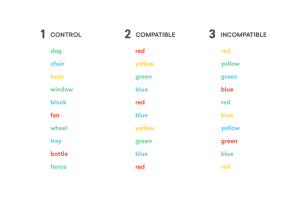 How did you do?
How did you do?
Most people have no problems with the first and second column, but have difficulties with the third column where the colours and the words are incompatible. The problem occurs because the automatic system is faster than the thoughtful system, and reading is a cognitive process that comes automatically to most of us.
Since emotions are faster and more in control than rational thinking, they have to be an essential part of brand communication.
Furthermore, brand-building campaigns build brand salience, which is one of the crucial traits that strong brands have. Brand salience is the degree in which a consumer thought about a brand or noticed a brand when in a buying situation. In one of the most influential marketing books in the past 15 years, “How brands grow” by Byron Sharp, this is called mental availability. Higher mental availability will have direct results on the brand’s business performance.
3. Brands should rethink their customer decision journey
The way marketing perceives the classic sales funnel and the path people go from awareness to buying has drastically changed in the last 10 to 15 years. A linear path, where a potential buyer has a number of brands in mind in the awareness phase and then the number drops as he moves through the other stages of the funnel, is now replaced by a more circular journey, as shown in figure 6.
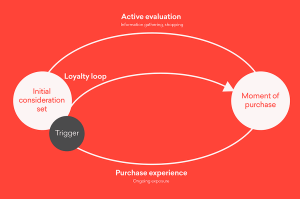
Figure 6: Consumer decision journey
Source: McKinsey & Company
The digitalization of media and consumer empowerment gave rise to this circulatory consumer journey, where after having in mind a certain number of brands in the initial consideration phase, consumers can drop the number of brands, as well as add them.
If you are buying a car and initially considering 5 brands of cars, you will probably add some brands in the active evaluation phase. You will look online for reviews of the car brands, you will look at how the brands’ websites look like and how they communicate on social media, you will ask your friends about what they would recommend, etc. In short, you will add x number of brands in the consideration phase, with the number depending on the specific product category and the amount of your consumer involvement.
Why is all of this important now?
How consumers act during times of crisis heavily depends on the nature of the product, as not all categories are affected similarly. It’s a big difference if a company sells luxury travel packages or low-priced sugar, but some general implications can be made.
During a crisis, consumers will take more time on gathering information in the active evaluation set than they do during periods of an economic upturn. They will take an extra effort to look at which alternatives are available, especially for products that the consumers need to be more heavily involved in, where the decision is complex and the perceived value/risk of decision is high. Even products that people buy habitually will be thought of more thoroughly.
As mentioned in the second part of the blog (importance of brand building) it is important for a brand to appear in the initial consideration set, as it elevates the chance of that specific brand to be bought. Digital channels play a huge role in the active evaluation phase, as more and more people use different digital media while looking for different alternatives.
Conclusion: Look at the economic downturn as an opportunity
How brands should act in an economic downturn is a complicated issue and I tried to simplify, as well as shorten some things. This really is an unprecedented moment in our history and it is hard to predict how long it will last, but as I tried to explain, research and history have taught us that there are some tactics that are proven to work. Brands and companies should adapt and try to look at the economic downturn as an opportunity.
However you look at it, there is a certain positive side to this situation that we should all look forward to. It looks that there could be more comedies in 2021! 🙂
